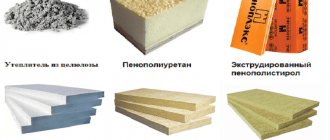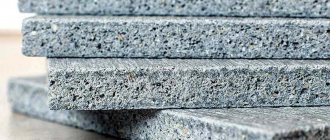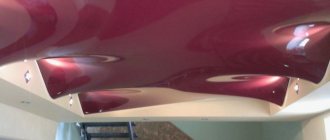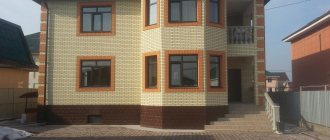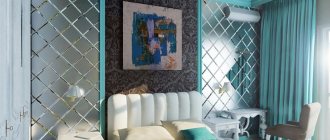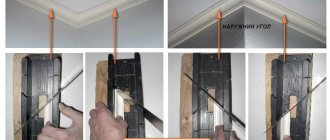Design and principle of operation of a warm baseboard
We can say that a warm baseboard is a fundamentally new approach to the issue of heating an ordinary apartment or private house. This system received this name due to its visual similarity to the usual baseboard and its compact size. Externally the design is:
- an aluminum box consisting of three walls - top, bottom and front;
- The thickness of the box is no more than 3 cm;
- The height of the front panel ranges from 10 to 24 cm;
- For decorative purposes, the ends of the box are closed with special plugs;
- Inside the box are heating elements that are attached to the wall using mounting brackets.
The principle of operation of warm baseboard heating radiators
Anyone who has been more deeply interested in economical methods of heating their home knows that the same radiators heat the room by convection. That is, the heat emanating from their surface heats the air. In this case, hot air rises up to the ceiling, where a thermal cushion is created, which displaces cold masses down. In rooms with low ceilings, this difference is not very noticeable and, in principle, comfortable conditions are created. But in rooms with high ceilings it is necessary to use forced ventilation, which will help mix air masses of different temperatures and warm them up as quickly as possible. In this case, most often in the corners of the room the air will still remain cold. Thus, warming up the entire volume of air in a room requires higher temperatures and longer times. Heat loss is 20-30%.
Surely, when using electric oil convectors, you noticed that next to the heater you feel warm, even hot, but literally a meter away from it the air is cold. In addition, the air becomes dry and foreign odors can often be detected.
The operation of a warm baseboard is based on gradual, uniform heating of adjacent walls and floors. Heating the air by convection uses no more than 30% of the radiated heat. Warming begins from the lower layers of air. The heat then slowly “creeps” up the walls, heating their surface in the process. Thanks to this, it became possible to achieve the same temperature throughout the entire height of the room.
thermal curtain.
Heat loss when using warm baseboards is only 5%. Needless to say, this method is economically beneficial? It has been proven that when walls are heated to a temperature of 37-38°C, a person becomes warm and comfortable even though the air temperature in the room is 16-17°C. A warm baseboard can be used as a complete heating system. Then you need to install it around the entire perimeter of the room. It can also be used as an additional source of heat in places where installing conventional radiators is impossible. For example, for heating a loggia with French glazing.
Double-glazed windows will not interfere with the full operation of the system. The warm baseboard is safe
Rating of the best warm skirting boards for 2021
Budget samples
2nd place: “Orion” 530 mm
This economical model is distinguished by high reliability and the absence of the need to install shut-off fittings. The sample works like a standard battery, but its heat loss is 6 times less. The body of the device is coated with a special protective compound, which stably protects it from possible corrosion. Can be used around the perimeter of swimming pools and on balconies with French glazing (panoramic windows).
| Name | Index |
| Heater type | Electric |
| Heating power, Watt | 75 |
| Control | Electronic |
| Section length, millimeters | 533 |
| Material | Aluminum |
| Price, rubles | 2700 |
Orion" 530 mm
Advantages:
- The box is treated with a special compound;
- Possibility of installation at different sites;
- Budget cost.
Flaws:
Thermostat is missing.
1st place: “Cozy” 1050 mm
Powerful and reliable model. It can be installed either as the only heating element in small rooms or included in heating circuits. Provides residents with special comfort: it does not dry out the air, does not fill it with combustion products, and does not create dust circulation in the room being served.
| Name | Index |
| Heater type | Electric |
| Heating power, Watt | 320 |
| Control | Electronic |
| Section length, millimeters | 1050 |
| Material | Aluminum |
| Price, rubles | 3600 |
Cozy" 1050 mm
Advantages:
- Large range of body color variations;
- Increased power;
- There is a thermostat for adjustment.
Flaws:
Afraid of high humidity.
Mid-range models
2nd place: “Orion 1 Cedar”
This model has an extremely pleasant appearance and can be used as a design element when decorating a country house. Sufficient power of this circuit will allow you not to freeze in the coldest times of the year. This sample is characterized by the production of rather long structural elements, which makes it possible to equip them with large perimeter rooms.
| Name | Index |
| Heater type | Electric |
| Heating power, Watt | 150 |
| Control | Electronic |
| Section length, millimeters | 1000 |
| Material | Aluminum |
| Price, rubles | 3800 |
Orion 1 Cedar
Advantages:
- Aesthetic appearance;
- Increased power;
- Simplified installation.
Flaws:
Again there is no thermostat.
1st place: “Mr. Tektum 2.0"
Another model designed for design projects. The heating device is made of hot-pressed aluminum alloy, inside of which brass and copper pipes are installed. Due to the fact that the model is liquid, installation is best done after preliminary heat calculations. Most experts recommend using this plinth for cottages and country houses.
| Name | Index |
| Heater type | Liquid |
| Heating power, Watt | 600 |
| Control | Manual |
| Section length, millimeters | 2000 |
| Material | Aluminum alloy |
| Price, rubles | 8600 |
Mr. Tektum 2.0
Advantages:
- High power for liquid instrument;
- Use of special alloys in construction;
- Recommended for design projects.
Flaws:
- High price;
- Difficult to install.
Premium class
2nd place: “Thermodul 13.17”
A rare representative on the Russian market of a line from a Western manufacturer. It is distinguished by the variability of the materials used and its high price. Import and trade into the Russian Federation is possible only with a certificate of conformity. Relatively difficult to install and requires original components for repair. It is better to entrust the installation of such equipment to professionals.
| Name | Index |
| Heater type | Liquid |
| Heating power, Watt | 500 |
| Control | Thermostat |
| Section length, millimeters | 1000 |
| Material | Aluminum alloy |
| Price, rubles | 16500 |
Thermodul 13.17
Advantages:
- The model is controlled by a thermostat;
- The design uses an innovative alloy;
- The warranty period has been extended.
Flaws:
Very high price per linear meter (in the absence of other advantages).
1st place: “Thermodul Combi”
Another expensive model from the Italian brand. It justifies its extremely high price (30,000 rubles/l.m.) 100%, due to the fact that it has a combined operating mode: it can work on both electric coolant and liquid coolant. However, it requires professional installation and adjustment of the entire circuit. The control is fully automated.
| Name | Index |
| Heater type | Liquid/Electric |
| Heating power, Watt | 650 |
| Control | Thermostat, fully automatic |
| Section length, millimeters | 1000 |
| Material | Aluminum alloy, corrugated |
| Price, rubles | 30000 |
Thermodul Combi
Advantages:
- Combination of operating modes;
- Fully automatic control;
- The latest materials in construction.
Flaws:
Not identified (for its characteristics).
Kinds
Today, only two types of warm baseboards are common - water and electric. Each of them is used in the specific conditions of the arrangement of rooms and the furnishings of the apartment itself. It is worth considering each of the types in detail.
Water
This installation option is quite common - it can be seen in the interior of some modern residential buildings, office premises, even shopping centers. It is worth noting that the water type of warm baseboard has become widespread in many Western countries. This interest is due to factors such as: ease of use and low maintenance requirements. A warm water baseboard is an externally metal panel or box, inside of which a heating or heating module with mini-pipes for supplying water and heating is placed. The outer or back side of the device is also equipped with a metal panel, which is already designed to protect the wall itself from high temperatures.
This method of connection is called beam by technicians. The difference between this type of warm baseboard and electric one is the wide range of possible installations in the interior. Warm water baseboards can be installed in attics, loggias, even on balconies, while the heating efficiency does not decrease, and energy costs remain relatively low. Another feature of the water type is the speed of heating of the air, since the physical properties of water allow even the hottest flows to be passed through pipes without hindrance. However, it is necessary to constantly monitor the temperature level in boiler rooms.
Electric
If the water type of warm baseboard is valued for its quick heating and ease of maintenance, the electric type is widespread due to the following characteristics:
- ease of installation work - unlike the water type, the electric type is installed on site, the installation process is simple and quick, because it is enough to fix the heating panels to the wall;
- the presence of more advanced heat regulation systems - most models of water baseboards are not equipped with special devices for measuring temperature - for this it is enough to monitor the average water level in the boiler rooms. The electric type is often equipped with specialized thermostats, which are similar to ordinary thermometers. Thermostats can operate either automatically or can be adjusted manually, and their work is aimed at optimizing energy costs.
It is also worth noting the negative aspects of using such a plinth:
- high energy consumption - when using any equipment with power supply, the question of monetary costs arises. The electric type, unfortunately, even with thermostats, consumes a large amount of energy;
- installation of the electrical type is much simpler, however, the connection process itself can cause some difficulties - this is the preparation of a dedicated line with the correct rating;
- One potential downside for many buyers is the power supply. The likelihood of damage to the wiring and a fire is extremely low, however, for some this is the determining factor under certain operating conditions.
If the buyer liked the water variety more, then do not despair and think that these species differ in external characteristics.
Apart from the presence of terminals or wire attachments to the electrical supply, these varieties are absolutely similar in appearance. It is worth noting this type of baseboard equipment as infrared warm baseboard. The peculiarity of this type is the use of a special film tape, which heats up under the influence of high temperatures and becomes a kind of source of infrared radiation, which provides additional and high-quality heating of the room.
Types of construction
There are several types of heating using baseboards:
- water;
- electric.
The choice of design must be made depending on the financial condition and the ability to ensure stable operation of all equipment in the system.
Water This option is a heating circuit or several through which a coolant circulates, having certain specified parameters.
Typically, either water or antifreeze is used for this.
The volume is approximately 340 grams per meter of heating structure. The operating temperature of the system can vary from 40 to 85 C.
Electric This type of heating system has a tubular heating element as the main heat source, with a power of 200 W per meter of the system.
The pipes in which these heating elements are located are provided with a serial connection to each other, and the temperature in them is controlled by special thermostats built into the system.
Watch the video, which explains in detail the features of use and the operating principle of a warm baseboard:
The best manufacturers
As already mentioned, the quality of the device is an important component of the reliability of the entire system. Today, there are more than one and a half dozen manufacturers represented on the domestic market, of which three companies have long-term experience and a positive assessment from consumers. Here they are:
- Mr. Tektum. This domestic company offers high-quality products at prices acceptable to Russian consumers. Warm water skirting boards mr tektum are highly functional and distinguished by their appearance: an aluminum panel with a stylish design.
- Best Board . The Austrian company offers products of the highest quality and energy-saving technologies. The company is a developer of innovative solutions that can significantly increase the efficiency of the device.
- Rehau. If you need real German quality, come to Rehau. These devices are extremely reliable and durable, and are famous for their long service life of several decades.
Pipe layout classification
To achieve maximum efficiency of the coolant in the radiator, you should carefully approach the installation. There are several types of heating system wiring, differing in design and number of pipes involved.
Classification of heating system wiring:
- plinth
- single-pipe;
- two-pipe;
- collector
There are also four options for mounting circuits:
- Hidden. In this case, the pipes are recessed into grooves in the wall or screed.
- Open. The pipes are placed outside, this option is less labor-intensive.
- Vertical.
- Horizontal.
Natural and forced flow of water in the pipeline is possible.
- Open. In this case, the expansion tank comes into contact with the environment. Because of this, you need to constantly monitor the water level in the middle.
- Closed. In this design, constant internal pressure is usually established. The expansion tank includes a rubber bulb with a metal casing. In this case, the liquid does not come into contact with the external environment.
What options are there for heating baseboards?
They produce baseboard heating convectors in electric or water versions, which are easy to install and connect. Various designs allow you to adapt to design features, existing surroundings and personal preferences.
Electric heated baseboard, which is simply controlled by electricity from a socket, is quickly installed and put into operation. A heating element is inserted into the lower tube. This is a low-cost alternative for spaces that are not used regularly or for properties such as holiday homes.
The water baseboard radiator for heating has proven itself in continuous operation and is connected to existing boiler equipment or city heating networks.
After familiarizing yourself with the advantages, a natural question arises about where to buy baseboard heating. It is necessary to make a calculation for the room: for heating 10 sq. meters you need 5 meters of plinth system. Therefore, the price of baseboard heating will depend on the amount of heated area.
Advantages and disadvantages: expert opinion
One of the advantages is undoubtedly its neat, almost decorative appearance. Radiators, even in size not much different from ordinary baseboards, take up very little space and are located where they do not disturb anyone - on the floor, near the wall. This means that there are more options for arranging furniture, and curtains can hang freely without clinging to the ribs of traditional radiators.
The warm baseboard has a modern look, takes up little space and fits into an interior designed in almost any style: from country to modern
Another advantage of the baseboard heating system is uniform heating of the entire area of the room. There are no zones of warmer or cooler air because there is no convection. Consequently, the temperature of the air gap under the ceiling and near the floor will be the same, and this has a beneficial effect on both human health and the condition of finishing materials.
Don't forget about saving. Fuel consumption is noticeably reduced due to the low heating temperature, by an average of 35-40%. In addition, the installation of skirting equipment is quick, as is its repair. It is possible to install a separate thermostat in each room and use it to control the heating: in the children's room, set the temperature a little higher, in the bedroom - a couple of degrees lower.
It is not recommended to create elements of a warm baseboard with your own hands, since there are no guarantees of its proper and efficient operation. It is better to purchase expensive but high-quality equipment from a well-known manufacturer
The disadvantages include the high cost of the equipment - about 3 thousand rubles for each meter. This amount includes special materials and installation of the system. Installation of equipment must be carried out by competent specialists who have permission from the manufacturer. By installing the system yourself, you can miss a number of important points, which will lead to rapid wear of the equipment and constant repairs.
It is advisable that baseboard radiators are not covered with anything: neither decorative overlays nor pieces of furniture. Heat transfer decreases sharply, and heating of the room becomes inadequate.
Despite some shortcomings, warm baseboards are becoming increasingly popular, and the time is not far off when it will completely replace today’s traditional convection-type systems.
Systems used for home heating are constantly being modernized and modified. Modern designs occupy a minimum of usable space and also effectively cope with the task. Such devices include the “warm baseboard” system.
Advantages of heated baseboards
- takes up little space (since there are no mounted radiators);
- efficient and environmentally friendly;
- energy saving and reduction of heating costs;
- healthy and pleasant heating thanks to radiant heat;
- flexible plinth in operation;
- quick and easy to assemble (including retrospectively);
- compact and aesthetic appearance.
Anyone who chooses foot heating receives a number of benefits that other heating systems do not offer or only partially offer.
Heating tapes operate inexpensively with electricity or water, and due to the radiant heat they emit, they provide even heat distribution and quick regulation or control via thermostats.
Optimal use of heat, stable operation allows you to save up to 28% energy compared to conventional systems. In addition to environmental protection, efficiency and cost savings, a pleasant indoor climate is also an advantage that this heating method brings with it. There are no cold zones and air circulation, as in conventional radiators.
With baseboard heating, the walls are not cooled, so there is no mold infestation! The even temperature also feels very pleasant as the air is neither too humid nor too dry. Allergy sufferers also benefit from a healthy indoor climate created by bottom heating.
Additional benefits: Heated skirting improves the appearance of a room, is almost invisible, can be installed in almost any property and room to save space, and is quick and easy to install.
Advantages and disadvantages
In order to give an objective assessment of skirting boards for heating pipes, it is worth studying the positive and negative aspects of such a floor system.
Among the advantages of the design, the following specific features stand out:
- Heat distribution in the room occurs in uniform flows over the entire area. The positive properties of infrared radiation include the ability to heat only translucent objects.
- The human body perceives such heating as a natural process.
- During heating, the bases acquire a temperature that is almost the same as the normal human body temperature. Therefore, imbalance when interacting with devices is eliminated.
- All bases, including walls, ceilings and windows remain dry, condensation does not accumulate on surfaces, which is especially important for rooms where panoramic windows are installed.
- The installation and installation of the system does not require the involvement of specialists, since the installation work is not particularly difficult.
- The presence of attractive decorative elements in the room has a positive effect on the overall interior.
- This design can be additionally equipped with thermostats, which will allow you to constantly maintain the optimal temperature inside.
- The average temperature of the coolant does not have a negative impact on heating productivity, since it becomes possible to save about 30% of the energy spent on heating.
Like any design, such a system has disadvantages. These include the following points:
- The length of the heating circuit hidden under the baseboard cannot be more than 15 m. Increasing it will lead to a decrease in the efficiency of the heating system. For large buildings, the question of using distribution manifolds will arise.
- Gaps in baseboards should not be blocked to maintain uniform heat flow.
- It is not allowed to install various decorative elements on the product, which may adversely affect the level of heat transfer.
- The price of the structure is quite high, since expensive raw materials are used during its assembly.
Price per meter of warm baseboard
| Image | Name | Panel length, m | Power, W | Average price, rub |
| MrTektum | 1 | 200 — 270 | 5100 | |
| MrTektum | 1,5 | 300 — 400 | 7700 | |
| MrTektum | 2,5 | 500 — 675 | 11300 | |
| MrTektum | 5 | 1000 — 1350 | 24900 | |
| MrTektum | 7 | 1500 — 2000 | 33900 | |
| Megador Standard-100 | 1 | 400 | 3600 | |
| Megador Standard-150 | 1,5 | 400 | 4250 | |
| Megador Standard-200 | 2 | 600 | 4750 | |
| TerModule | 1 | 140 | 14400 | |
| TerModule | 1 | 200 | 13300 | |
| TerModule | 1 | 300 | 12000 | |
| TerModule | 1 | 400 | 11800 |
Types of heating baseboards
The baseboard heating system can be of two types: with electric and water heaters. At the installation stage, a system with warm water baseboards is more complicated (a collector or radial connection is required), but during operation it is more economical. An electric warm baseboard can be installed quickly - you just need to fasten the heaters to the wall, and immediately after installation it is ready for use. But heating costs, like any electric heating, are high.
One of the most inconspicuous heating systems is a warm (heating) baseboard
Heating device with warm water baseboard
The water baseboard heating system differs only in the non-standard shape of the heating devices. The key components do not differ from the standard ones: you need a hot water boiler, a collector unit and a pipe system with which the warm baseboard is connected.
There is also a combined warm baseboard - with an electric heating element and pipes for coolant
Please note: the optimal operating mode of the system is low temperature. Supply 40-50°C, return about 5°C lower
Therefore, you need to select a boiler or build a system based on this. If the boiler is gas, the best choice is a condensing boiler. When installing any other, the system requires a heat accumulator and/or a mixing unit to reduce and stabilize the temperature.
Connection method
There are also features in choosing the connection method. Connecting all baseboard heaters in series in a room is ineffective: by the time the coolant reaches the last ones in the heater branch, it will cool down greatly and they will remain cold almost all the time.
The radial connection diagram looks something like this
For a water heating baseboard, a radial system is used: devices are connected one at a time or in pairs. To do this, a collector unit is built into the system, to which the pipes that go to the heating devices are connected. The disadvantage of such a system is the high consumption of pipes. After all, each device (or small group) has two pipes - supply and return. The pipe flow rate is much higher, but the heat distribution is more uniform and the system itself is more reliable. Why is it more reliable? If pipes or radiators in one group are damaged, all others work normally.
Installation features
When installing water baseboard heating, the pipes are usually hidden in the floor. It will not be possible to lay them along the walls, since the space is occupied by heating devices. That is, installation of warm water baseboards is possible only at the renovation stage - the floors will have to be raised.
Very attractive when assembled
It is recommended to lay special polymer pipes in the screed - they are not subject to corrosion and have low heat transfer, that is, heat loss during transportation of the coolant will be small. But since these systems have limited availability for repairs, you need to buy high-quality products from well-known manufacturers, and this is not cheap.
Electric warm baseboard
An electric heated baseboard differs in appearance from a water baseboard only in the presence of terminals for connecting power. Otherwise the view is the same. These are two tubes with perpendicularly fixed aluminum/brass/copper plates. In the lower tube there is a heating element - heating element, in the upper tube there are wires for connection.
General design of a heating baseboard
Installing and connecting an electric heated baseboard is much easier. You just need to secure it, stretch the wires and connect them to the terminals. To maintain the set temperature, a thermostat is built into the system, which turns the heaters on and off. The use of thermostats is desirable, as it optimizes operation and saves electricity.
Installation is really simple, but you need to connect the electric warm baseboard to a dedicated line with a correctly selected circuit breaker rating and single-core copper wires of the appropriate cross-section. So in this case, repairs are required - it is customary to lay the wiring in the wall, and for this you need to make grooves, that is, break the walls.
Principle of operation
Like conventional heating devices, the main task of a warm baseboard is to heat the room, but the very principle of its operation is very different from standard heating devices, which only due to high heating transmit heat into the surrounding space.
The baseboard heating system meets the most modern requirements for energy saving and respect for the microclimate of the house.
It is based on several operating principles:
- The first of them is that they install it, like an ordinary decorative plinth, around the entire perimeter of the walls of the home.
- The second principle is to ensure heating not only of the air in contact with the baseboard, but also of all the walls of the house along the perimeter of which it is mounted, which means that the heated walls will stop consuming heat from the surrounding space and will become an insurmountable barrier to the cold.
- The third principle is to ensure uniform air convection in the room, that is, heat is distributed evenly even between the floor and ceiling, which means that in such a room you will not need to simultaneously sweat in a T-shirt from the stuffiness and freeze in warm socks due to the creeping semi-cold.
- And finally, which is important for housewives who care about cleanliness, the rise of warm air from the floor does not occur very quickly, which means that clouds of dust will not rise with it.
In general, this entire plinth system works on the effect of “sticking” the air heated by it to the surrounding surface, the largest of which in terms of area in the house is the wall.
Baseboard radiators are installed around the entire perimeter of a house or apartment where heating is required. The heating elements are built into metal boxes with a lower inlet slot for cold air and an upper outlet for warm air.
At the same time, they do not easily throw warm air into the surrounding space so that it somehow mixes there and warms up the room. And they represent a finely regulated microclimate system, since a warm flow is purposefully released along the wall, so that it can then heat the entire room as evenly as possible. Current- and heat-conducting elements of such equipment are made of non-ferrous metals: copper and aluminum.
The heating elements themselves operate at temperatures ranging from 40 to 70 degrees Celsius, transferring a significant portion of this heat to the wall. Therefore, there is no need to heat the radiators in the baseboard to the maximum, because even with a regulator value of 40 degrees, the wall can warm up to the temperature of the human body, which is absolutely safe even for children.
Heat plinth: design features
It became possible to buy a warm baseboard not so long ago. In fact, this system was designed with the aim of increasing heating efficiency while using less energy. Moreover, such panels look very original, and warm baseboard technology often allows you to completely abandon the use of traditional heating methods using radiators.
Externally, the heating panel looks like an ordinary floor plinth
Externally, the heat plinth is a strip made of aluminum that covers the internal contents of the box. If it were not for its very modest dimensions, one could call it a full-fledged heating device, however, the fact that the box has a low height, does not protrude much from the wall and is mounted along the perimeter of the room on the wall near the floor gives it the right to be called a plinth.
Inside the box there is a heating system, which may differ depending on the type of baseboard chosen. You can understand what the difference is by considering the existing types of warm baseboards.
The principle of operation of baseboard heat as a heating device
Obviously, this heating device got its name due to its location. The warm baseboard is attached in the same place as a regular one - around the perimeter of the room. The main advantage of such a heating system is that the device heats not only the air around it, but also the walls with which it comes into contact. This system allows for better heat retention and reduced heat loss.
The fact that air convection is reduced and the heat is evenly distributed throughout the room, without concentrating in one place, as is often the case with traditional radiators, also has a positive effect. A significant advantage is that due to the slow movement of air from the baseboard to the ceiling, dust practically does not rise from the floor. And this not only makes cleaning much easier, but also has a positive effect on the health of residents.
An electric warm baseboard was used to heat the room.
The temperature limits within which the device operates are 40-70 degrees and using a thermostat you can set the indicator within these limits. According to reviews from the owners, a warm baseboard never allows the air temperature to drop below 20 degrees, and this can be considered a completely comfortable temperature for living. Of course, this applies to cases where the calculations of the required number of elements and their power were carried out correctly.
If we are talking about installing an electric baseboard, then it is also worth noting the fact that, like one section of any traditional radiator, one segment of a warm baseboard emits 190 W of heat. At the same time, the energy consumption for its production is 3 times less, and this is a considerable saving for the entire heating season.
As a heating device, a warm baseboard can be installed in almost any room. Neither the size nor any location of the room can serve as a contraindication to its installation. It is generally accepted that this design option is ideal for rooms with panoramic glazing, where ordinary radiators under the windows simply will not fit.
Warm baseboard is an ideal solution for installation in a room with panoramic windows
This is interesting: Long-burning pyrolysis boilers with a water circuit
Electric warm baseboard: price and manufacturers
The costs of electric baseboard heating systems depend on the complexity of the installation and the quality of the materials. The price of an electric warm baseboard ranges from one and a half thousand to four thousand rubles, depending on the power and design.
The color of the heater can be matched to the walls
The most popular manufacturers in this market are the Austrian BestBoard, the Ukrainian Thermia and the domestic Tektrum. Austrian products are distinguished by their quality and aesthetics, but they are also more expensive than others. In addition to these manufacturers, there are many companies offering their products. Before you buy an electric skirting board, you need to carefully read the reviews. Sometimes they help in choosing more than any, even a detailed analysis of prices and technical characteristics.
Kinds
Currently, the Rehau company produces a considerable number of different models of heating pipes.
Experts include the most common samples:
- Rautitan;
- Stabil;
- Flex;
- Pink;
- His.
Rautitan
This model of Rehau pipes is universal. Often such a sample is used for radiator heating (for installing an internal heating network). According to some experts, the quality of the Rautitan product not only meets the European standard, but also significantly exceeds it.
Rautitan pipes are durable products that consist of cross-linked polyethylene and black sleeve fittings.
Stabil
This option is also considered universal. Most often, pipes of this model are used for installing hot and cold water supply systems. They consist of heavy-duty cross-linked polyethylene with special reinforcement inside. The diameter of such a sample is most often 16 mm.
It should be said that Rehau Stabil pipes can easily withstand even severe freezing. In addition, they have a special oxygen-protective layer. Many experts and consumers note that the service life of these building elements is at least 50 years.
Flex
This model is focused exclusively on heating systems. Moreover, it is suitable for both standard radiator heating and modern heated floors. The Flex sample is a one-piece pipe that consists of cross-linked polyethylene. The thickness of its walls is 3-8 mm, so it is quite flexible, but at the same time durable.
Rehau Flex pipes are coated on the outside with a special wear-resistant protection layer. It is designed to avoid various scratches, damage and abrasions on the surface of the product. The maximum operating temperature for this model, as a rule, is at least 80 degrees. The diameter of such a sample is most often 16 mm.
Pink
This type is also created by manufacturers exclusively for the installation of heating systems. Rehau Pink pipes have increased temperature characteristics. So, they can easily withstand fluctuations up to +130?. The diameter of this model can reach 20 mm.
Such pipes are made from special molecular cross-linked polyethylene with a protective layer. Thanks to this material, the products are quite strong, reliable and durable. The Rehau Pink model has a characteristic pink color.
His
Often, the His pipe model is used to install heating systems. It consists of polyethylene cross-linked using the peroxide method. It should be said that if you choose just such a sample, then you will have to buy additional branded components, without which it will be impossible to fasten the parts.
It is important to note that the Rehau His model comes in a variety of sizes. So, the diameter of such a pipe can vary significantly (from 20 mm to 60 mm)
The wall thickness can also be different (from 2.2 mm to 8 mm). According to most experts, this sample has increased resistance to corrosion, high impact resistance and wear resistance, which is why it is often used for various plumbing systems.
Calculation of the required number of skirting boards
We have already seen that the warm baseboard system is a very successful solution for heating not only an ordinary apartment, but also private houses. Now let's try to understand the issue that will be of interest to those who really decide to purchase this equipment. For more correct calculations, it is necessary to take into account the heat loss of the room. This is influenced by the type of glazing, the number of window openings, whether there is an end room or not, the thickness of the walls and their covering, and much more.
You should also build on generally accepted standards, which state that for heating 1 sq.m. A living room needs 60-100 W of heat. These figures are relevant for residents of the middle climate zone. For more northern regions, 150-200 W of heat will be required.
Now you need to multiply the area of the room by the average, for example 12 m2 × 150 W = 1800 W. To this indicator you need to add a small margin, but without fanaticism.
How to calculate the length of a water heating element
The choice of dyne is primarily influenced by the thermal pressure of the system. Please note that warm baseboards refer to systems that do not operate at high temperatures. And the difference between the temperature of the supply coolant and the return one is no more than 5°C. Thermal pressure can be calculated using the formula
∆T = ((tп+to)/2)-tв, where
- tп – temperature of the supply coolant;
- tо – return medium temperature;
- tв – room air temperature.
It follows that to maintain a room temperature of 20°C and a coolant temperature of 70°C, we have a thermal pressure that is equal to ((70+65)/2)-20 = 47.5°C.
Now, thanks to the data given in the table, you can see how much heat will be generated by 1 linear meter of warm water baseboard. For a value of 47.5°C it is equal to 218 W. To heat a room of 12 m2, which requires 1800 W of heat, you need 1800/218 = 8.25 meters of baseboard. The indicator can be rounded up or down at your discretion.
How to calculate the required length of an electric warm baseboard
In this case, everything is much simpler. You can calculate the required amount to heat a room of any size based on average statistics, as in the example above. Next, look carefully at the packaging, which will always indicate the heat transfer value per linear meter of the product. The number of meters is determined by dividing the required amount of heat per room by this value. For example, to heat a room of 12 m2, which requires 1800 W of heat, you need 1800/190 = 9.47 meters of baseboard. The indicator 190 is taken conditionally.
Types of baseboard heating
Baseboard heating is divided into water and electric. Accordingly, water systems operate on the basis of gas or any other boilers. Electrical systems are built on the basis of baseboard electric convectors.
Water systems
Water heating systems are built on the basis of the radiators described above, made of non-ferrous metals. Hot coolant, prepared by a heating boiler or obtained from a central heating system, circulates through them.
Water baseboard heating can be used to heat rooms for any purpose - these can be halls, corridors, kitchens, children's rooms, living rooms, shopping areas and much more. In addition, it is well suited for use in rooms with panoramic glazing - baseboard radiators will prevent the penetration of cold and protect against the formation of condensation.
The “warm baseboard” heating system is recommended for installation in individual households. But its use with a centralized coolant supply can lead to an accident - baseboard heating does not tolerate water hammer. Some experts recommend using an intermediate heat exchanger, but in this case certain heat losses will be observed.
A water baseboard heating system consists of the following parts:
- Radiators - they are miniature convectors made of non-ferrous metal. They are the sources of heat for heating rooms;
- Protective boxes - they cover the radiators and pipes themselves;
- Pipes - in most cases, metal-plastic pipes are used here, as they are more resistant to pressure and high temperature.
The installation of a water baseboard heating system is carried out in such a way that it does not form a complete ring throughout the house - this would cause uneven heating. Therefore, the most common practice is to create separate directions for each room. To do this, distribution manifolds are installed in the heating system, to which coolant is supplied from the boiler.
The main advantage of using a distribution manifold is the ease of repair work in the event of an accident. It will also allow you to adjust the temperature in each direction separately.
Electrical systems
Electric baseboard heating is intended for use in buildings not connected to gas mains. It involves the use of small-sized convectors, powered from the mains. In their design, they are similar to water radiators, only instead of tubes with hot coolant, powerful heating elements are used here.
Electricity in our country is quite expensive, so using electric heating can lead to high costs. But in many cases it remains the only available heating method.
As in water systems, in electric heating it is desirable to use a circuit with several separate directions. That is, each room is powered by a separate electrical cable. A special electrical panel is installed in the building, in which circuit breakers are installed. From here the cables disperse throughout the rooms. If a room is not in use, it can be turned off, thereby saving energy.
Electric convectors work on the same principle as water ones - they produce heated air, which seems to “stick” to the walls and is sent upward. At the same time, cold air masses are sucked into the equipment and undergo the next heating stage. After some time, the room will become noticeably warmer.
The main advantages of electric baseboard heating over water systems:
- Increased reliability - the use of modern heating elements allows us to guarantee a service life of up to 20-25 years, while for water appliances this period is about 10 years;
- There is no coolant - which means there is no risk of flooding the neighbors;
- Easier installation - laying the cable is much easier than fiddling with pipes.
The main disadvantage of any electric heating is its gluttony in terms of electricity consumption - combined with electricity tariffs, the costs will be high.
Related Posts
- Baseboard and floor electrical sockets. device and installation
- How to cut metal using a grinder
- Which pipe to choose for heating
- Leningrad heating system for a private house
- Disadvantages of polypropylene pipes in home heating
- How to make steam heating
- Insert for suspended ceilings
- Pipe box
- Connection diagrams for bimetallic radiators
- Which rehau pipes are best for heating and water supply?
- What kind of pipes are used for the gas pipeline?
- Dismantling of heating systems
- Do-it-yourself heating options for a country house
- Which pipes for heated floors to choose: characteristics and installation methods
- A supply of hot water that is always at hand: how does an electric water heater for heating work?
- Economical heating of a private house and apartment
- Online calculation of the capacity of round and rectangular profile pipes
- Decorative overlay for a heating pipe: what is better to choose to make it look beautiful?
- Types of bath skirting boards and their installation
- Warm floors on a balcony or loggia
- Major heating repairs in an apartment building
- Electric heated floor in a private country house: installation features in a wooden and frame house
- Choosing between metal-plastic and polypropylene pipes
- We make a water heated floor from a gas boiler
- Hydroarrow: principle of operation, purpose and calculations
Read with this
- Baseboard and floor electrical sockets. device and installation
- How to cut metal using a grinder
- Which pipe to choose for heating
- Leningrad heating system for a private house
- Disadvantages of polypropylene pipes in home heating
- How to make steam heating
- Insert for suspended ceilings
- Pipe box
- Connection diagrams for bimetallic radiators
- Which rehau pipes are best for heating and water supply?
Do-it-yourself installation of warm baseboards
In addition to the high cost of the system itself, you will also have to pay a significant amount for its installation. In this case, the calculation is made for each linear meter. Based on this, many people have a question: is it possible to install a warm baseboard system yourself? We can say that if you have the skills to work with electrical wiring and plastic pipes, as well as due attention and legibility, this is not so difficult to do.
Self-installation of warm water baseboard
To carry out the work you will need the following materials:
- Metal-plastic pipes;
- Thermal insulation material;
- A collector equipped with taps;
- Metal and plastic adapters;
- Set of tools.
Installation should begin with the installation of the collector. It is necessary to connect a pipe to it, which will provide its power. A boiler running on any type of fuel can be used as a source of coolant. The only condition is that for the system to operate correctly, it is necessary to provide a pressure of at least 3 atm. After you calculate the required length of the plinth according to the recommendations from point 6, you can begin laying the pipes.
It must be remembered that the maximum length of the circuit should not exceed 12.5 or 15 m depending on the manufacturer
And that there should be two pipes in the system - one for supply, the other for coolant intake;
It is also important not to forget about thermal insulation to reduce heat loss. To do this, you need to lay special material around the perimeter of the room between the wall and the pipes; Now you need to screw the base to which the heat exchangers will be attached
The plank is attached using self-tapping screws. Please note that the finished baseboard should not lie flush to the floor. Leave a gap of about 1 cm to prevent the device from overheating;
Now secure the modules and connect them together using crimp fittings; When the structure is assembled, you need to connect it to the common highway by installing a collector; Before final assembly, be sure to check the system for leaks. To do this, perform a test run, which will also show the correct operation; If the system works reliably, secure the front panel to the baseboard. This is very easy to do, following the recommendations in the instructions.
Self-installation of electric heated baseboard
Installing an electric baseboard requires completely different skills and attention to slightly different factors. It is recommended to connect the system directly to the panel and equip it with a separate circuit breaker. How many circuits there will be in your apartment or house, there should be as many separate lines. Choose wires with a large cross-section that can definitely withstand the load (at least 2.5 mm). Do not forget about the need to connect a thermostat for each circuit and a temperature sensor for each room. This will help set the most optimal temperature for each room.
- The installation should begin with the laying of thermal insulation material;
- Then screw the base of the plinth;
- Attach heat exchangers to it;
- Make a parallel connection of wires;
- Carry out a thorough visual inspection to ensure there are no uninsulated areas;
- Close the structure with the front panel;
- Connect the heating circuit to the thermostat and connect it to the distribution panel;
- Perform a test run of the system.
The gap from the floor to the baseboard should be at least 1 cm, and the distance from the wall at least 1.5 cm. This will ensure proper convection and protect the system from overheating.
Scope of application
The baseboard heater can be installed in:
- private houses;
- apartments;
- educational institutions;
- medical institutions;
- sports centers;
- shopping complexes;
- public catering buildings;
- greenhouses;
- exhibition halls;
- office premises.
Let me put it briefly: in principle, a baseboard heater is appropriate everywhere.
Warm baseboard: Anyone can make a budget heating system with their own hands - Instructions + Video
Warm baseboard - budget heating system with your own hands. One of the main factors for comfortable living in a home is the temperature inside the room. There are many types of heating systems. One of them is a warm baseboard, a relatively new type of heating.
The good thing about it is that you can make it yourself. With a wide range offered by manufacturers, prices for the structure itself and its installation can be steep.
Therefore, the budget option, “do-it-yourself warm baseboard,” is more preferable.
General information
The compact design does not reduce its effectiveness. The time required for design and installation is the same as for installing standard radiators. Masking the heating parts with an aluminum profile, such a plinth does not spoil the interior of the apartment. It has low sides and evenly distributes the heat that flows along the floor and walls of the room.
There are two types of baseboards, which differ in the type of coolant (water, electricity) and, accordingly, structural elements and connections.
Review of warm skirting boards
Electric warm baseboard
From the beginning, insulating tape is glued along the level of the bottom bar. Then there are metal brackets, on which there is a heating module made of copper tubes connected by brass fins in a heat exchanger. The front panel can be of any color. The factory heat exchanger consists of plates. They are the most expensive material of construction. If you replace the plates with pipes, you can save a lot.
The design of a factory plinth consists of a large number of elements. This is a heat exchanger, elbow, plugs, profiles and much more. To make a warm baseboard with your own hands, you will need a set of self-regulating heating cable EHL30-2CR RST. It can change resistance depending on temperature changes. Operating temperature from -40 to +65, maximum +85 degrees. Power 35 W per linear meter at a temperature of zero degrees.
The footage must be taken with a reserve. A set of heat-shrinkable tubes for connecting the cable and electrical plug. Corrugated stainless steel pipe. Its thermal conductivity is less than that of copper, but better than plastic. Ceiling guide profiles plus self-tapping screws, mounting tape and brackets.
Reference! Insulation can be used NPE-LF type C with a coefficient of surface thermal reflection of 97% with water absorption in 24 hours of 0.94% moisture. 5 mm thick.
We prepare the heating cable. We weld the end with special heat-shrinkable tubes. We connect to the power supply and check. Turn it off and carefully put on the corrugated tube. After half an hour we look at the heat transfer. If everything is in order, we begin installing the plinth indoors.
We lay a pre-prepared corrugated cable around the entire perimeter of the room, look at the dimensions again, and modify if necessary. We glue insulating tape to the wall where we install the structure. Insulation pre-cut into strips 6-8 cm wide. We mount an aluminum ceiling profile from the corner, securing it with self-tapping screws.
Next, we lay a corrugated tube with a cable into it and secure it with staples. This version of a warm baseboard is suitable for heating a garage or veranda. For premises in a residential building, it is necessary to provide a top panel. It can be any color you like without spoiling the design.
Reference! When using a self-regulating cable, you do not need to use sensors and heat regulators.
The entire project will cost between 500-600 rubles per linear meter. If you purchase a heating cable of lower power, the price will decrease significantly. You can also use a metal sleeve.
Water warm baseboard
The technology of operation and production of warm water or liquid baseboard is simple to implement. The heating element here is water or a special liquid. And the heater is the boiler. The system is cyclical, that is, water is supplied to the radiators and returned back to be reheated. The boiler is equipped with a thermostat.
Reference! Any type of boiler is suitable for this type of heating. Gas, electric and even coal/wood.
The simplest and most cost-effective solution for a warm water baseboard is to take a galvanized plumbing pipe 15mm in diameter. Using a welding seam using the “point” method, grab a sheet of iron, bend it in advance along the required radius and weld the perimeter with a continuous seam.
Cover the top with paint. Or run 4-6 pieces of half-inch stainless corrugated pipe along the baseboard using the same technology. This will help remove excess moisture. It will prevent mold and mildew from forming in corners and on walls.
A more expensive way to make a warm baseboard is to purchase a copper roofing strip and pipes of a suitable diameter. We cut the strip into pieces of the required size. We connect with a gas burner. We form a continuous line and mount it to the wall using insulation clips. We fill the entire system with liquid material, having previously connected it to the collectors and the boiler.
The copper plinth can be painted if desired, but it will look noble even with a natural color. This method can be used in residential premises.
Attention! For any construction, electrical, or gas-electric welding work, it is advisable to contact specialists.
Characteristics
The warm baseboard heating system is very well suited for buildings with poorly insulated walls, in log houses, for example. The heat from the baseboard will warm up vertical surfaces well, rising upward. The comfortable temperature also extends to the floor. There is no feeling of a draft on the legs.
Efficient and cost-effective use of the system allows you to pay lower energy bills. Easy to care for. It is easy to repair and replace elements, so this type of heating is durable. You can adjust the room temperature level by simply pressing a switch.
In general, a large number of components for the manufacture of a structure can be calculated on your own. It is necessary to take into account the size of the rooms, the cost of collectors, tubes made of the desired material, cable, and calculate heat loss. Take into account all elements at the design stage. If you want to study professional literature, you can do everything yourself with high quality and cheap.

